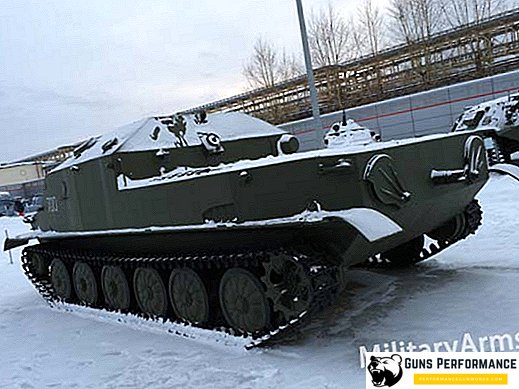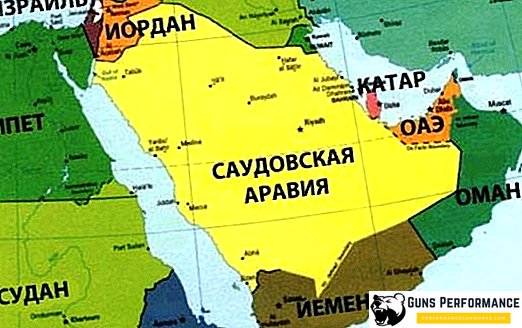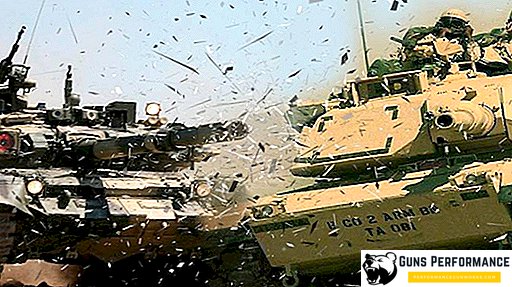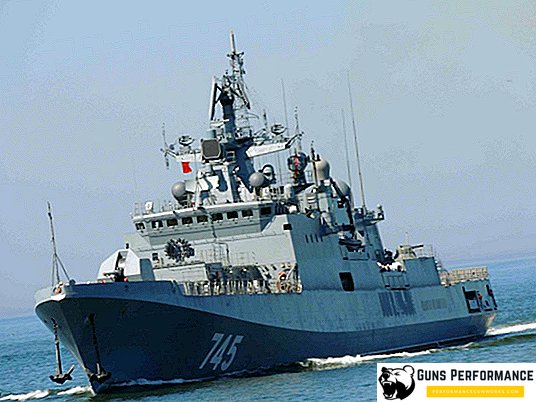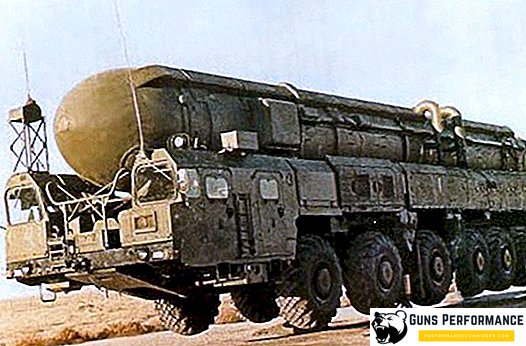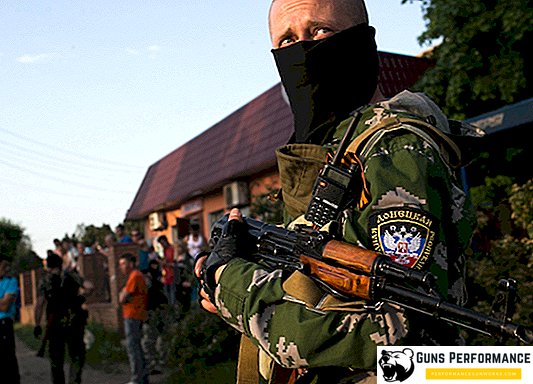Aviation and the navy form the basis of the military power of the United States of America. Do not believe the common myths that Americans do not know how to fight on land - this is absolutely not true. The US Army is able to conduct successful ground operations against any enemy. However, since the advent of combat aircraft, the US ground army has never waged war without securing air superiority. Apparently, this trend will continue in the foreseeable future, because there is no other force capable of challenging the US Air Force today and it is not foreseen.
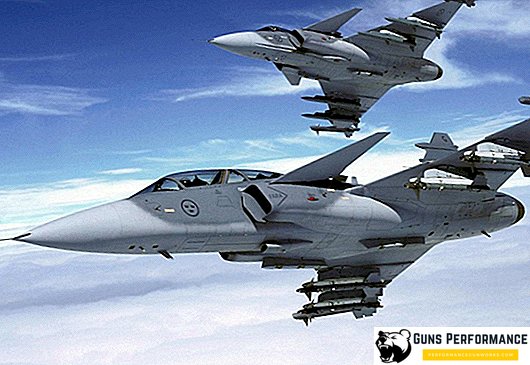
In addition to striking power, the US Air Force provides high mobility of the American armed forces. In this, no army in the world comes close to the United States. The Air Force is a special type of military for the United States, which consists of two components of the strategic triad: intercontinental ballistic missiles and strategic aviation. It is the United States Air Force that is a kind of attraction pole for most of the innovations that Americans are actively using in the military industry.
US military aircraft is currently the strongest on the planet. Now she is experiencing some difficulties associated with the transition to a new technique and a significant age of aircraft currently in service. But today, the United States can win the war against the overwhelming majority of opponents, using only aircraft, even without using its ground forces and fleet.

US Air Force History
The United States Air Force as a separate type of troops appeared only in 1947, after the adoption of the National Security Act. First of all, military aviation was part of the ground forces and the US Navy. Before the official birth, the US military aircraft had gone their way in forty years.
The first aviation unit in the US Army appeared in 1907, it was called the "aeronautic branch of the Communications Corps." Only in 1908, the first aircraft appeared on its armament; the Corps was engaged in testing heavier-than-air vehicles and training pilots.

After the United States entered the First World War (1918), combat aircraft became part of the American expeditionary forces in Europe. In the same year, the US Army Aviation Service was organized. American pilots actively participated in the air battles of the First World War, providing tactical support to their own troops. The best American pilot of that war was Edward Rickenbacker, who counted 21 aircraft and 4 enemy airships.
In 1926, the US Air Force was reorganized into the Air Corps of the US Army, in this form, they entered World War II. This conflict began for America with the attack of the Japanese on the Pacific naval base Pearl Harbor, and ended with the atomic bombings of Japanese cities. It is difficult to overestimate the importance of aviation in the victory over Japan and Germany.
In the first months of the war, Americans suffered heavy losses in the Pacific theater of military operations, but in 1942, US aircraft began to strike at the territory of Japan.
The American industry very quickly managed to establish a massive production of excellent combat aircraft, which were used not only by the Americans, but also supplied to the allies. The real symbols of that war were the P-51 Mustang fighter and the B-17 Flying Fortress bomber. In addition to these aircraft, large numbers of P-47 Thunderbolt fighter-bombers, a heavy B-24 Liberator bomber and other combat and transport aircraft were produced.

During World War II, the United States actively began to use strategic bombers for the first time to destroy enemy infrastructure.

After the landing of the Allied forces in Normandy, American pilots begin to provide tactical support to ground units. At this stage of the war, the superiority of the Allies over the German Air Force was overwhelming. In the skies of Europe, American pilots shot down 35 thousand enemy aircraft, losing 18 thousand of their own vehicles. The losses of the US Air Force in the Pacific theater of military operations amounted to 4.5 thousand aircraft, the Japanese lost 10 thousand of their cars.
Nuclear bombing of Japanese cities opened the beginning of a new era in human history.
After the end of the war, the air force was significantly reduced (from 2 million to 300 thousand people), the air bases were closed, thousands of aircraft were destroyed. The Americans had a monopoly on nuclear weapons and, therefore, believed that their power would be enough to destroy any adversary.

At the end of the war, a revolution occurred in aviation technology - the era of jet aircraft began.
The US Air Force began a gradual transition to jets, but the pace of rearmament was unsatisfactory.
On September 18, 1947, the National Security Law was passed, according to which the Air Force became an independent type of US military. In the same period, active work is underway on the creation of a new strategic bomber.
In 1948, the USSR began the blockade of Berlin, and the US Air Force took part in the first large-scale humanitarian operation to deliver various goods to the besieged city. At certain periods, transport aircraft delivered daily to Berlin up to 6 thousand tons of cargo of the widest range (from coal to baby food). Prior to this, operations of such magnitude have never been carried out. After Berlin, it became clear that aviation is capable of performing another strategic task: to transfer a significant number of troops to any part of the world and ensure their uninterrupted supply.
The next serious test for the US Air Force was the war on the Korean Peninsula. If it were not for the support of aviation at the initial stage of the war, then the allied forces would most likely have suffered defeat. Already in 1950, the newest Soviet MiG-15 jets began to appear in Korea, the number of which was constantly increasing. American pilots were prohibited from striking enemy airfields on Chinese territory, where MiGs were located.
The war in Korea clearly showed that a significant reduction in the US Air Force was a mistake, therefore, in the early 1950s, funding for the air force was sharply increased. During this period, the B-52 bomber was developed, and new types of fighters and tactical bombers were also adopted.

The next few decades went down in history as the period of the Cold War — a fierce confrontation between the Warsaw bloc and the countries of the West. At this time, the confrontation between the USSR and the USA reached its apogee, the world repeatedly approached the dangerous brink of large-scale thermonuclear war.
Airspace was one of the major fronts of superpower rivalry. Both countries sought to create more sophisticated models of aircraft and air defense systems. Records were set in range, speed and altitude, they did not spare funds for research in the aerospace field.
An important milestone for the US Air Force was the Vietnam War. The first bombing of North Vietnam began in 1964, almost immediately after the incident in the Strait of Tonny. In 1965, a large-scale operation was launched by the US Air Force called Thunder. Its goal was to destroy the military and civilian infrastructure of North Vietnam, as well as suppress the will of the Vietnamese to further the struggle.
American aviation was actively used until the cessation of hostilities in 1975. During the Vietnamese campaign, the US Air Force, the US Navy and the Marine Corps aviation lost 3,374 aircraft.
Back in the 60s of the last century, the development of the fourth generation fighter began, the first representative of this class of vehicles was the F-15 Eagle. It is operated today. A little later, work was completed on the F-16 Fighting Falcon, which for many years was the basis of US fighter aircraft.


During these years, work was actively promoted in the creation of aircraft with reduced visibility for radio electronic means of detecting the enemy ("stealth"). The result of this program was the creation of aircraft F-117 Nighthawk, B-2 Spirit, and then the fifth-generation fighter.


The US Air Force was actively involved in Operation Desert Storm (1990); moreover, it was the Air Force that made the main contribution to the coalition’s victory in this conflict. In this war, the United States lost 40 aircraft and 23 helicopters, and several dozen UAVs were also destroyed.


The US Air Force participated in several NATO operations in Yugoslavia (the last in 1999), which eventually led to the fall of the country's ruling regime and the disintegration of the Yugoslav state.
In 2001, the US Air Force was involved in the operations of the US Army in Afghanistan and Iraq (2003). Basically, the US Air Force used to support the ground units of the American army.

Currently, the aircraft of the US Air Force are involved in the fight against ISIS terrorists in Syria.
US Air Force Structure
In its composition, the US Air Force has a ministry, the headquarters of the Air Force and eleven commands. In addition, the structure of the American air force includes 27 agencies on the rights of command.
The US Air Force also includes airplanes that are listed as the country's National Guard. According to its charter, this organization must protect the territorial integrity of the United States, but since no one has ever attacked the Americans, the National Guard under the pilots perform combat missions on a par with the pilots of the air force.
Supervised by the US Air Force US Secretary of the Air Force. Since 2013, this post is held by Deborah Lee James. However, the Ministry deals only with the political and administrative leadership of the Air Force, determines its development directions, is responsible for conducting research in the development of new aircraft (LA) and weapon systems, and also deals with financial matters. A US civilian minister is appointed as a civilian, does not have military ranks and his deputies and their advisers.

The headquarters of the United States Air Force is engaged in organizational matters, operational and combat training, logistics, develops plans for the use of the air force and regulations for military personnel. The headquarters also takes part in the development of new types of weapons and aircraft, distributes equipment among parts and divisions. Currently, the headquarters is led by US Air Force General Mark Welch (since 2012). Geographically, the headquarters of the United States Air Force is located in the Pentagon, in the state of Virginia.
Here is a list of commands that are part of the US Air Force:
- Combat aviation command. The headquarters is located at Langley airbase, Virginia. It includes the 1st, 8th, 9th, 12th air armies and the center of combat use of the Air Force.
- Training Aviation Command. The headquarters is located at Randolph, Texas. The structure includes the 2nd air army, the 19th air army, the air force university and other units.
- Air traffic command. The headquarters is located at Scott Air Base, Illinois. The command includes the 18th Air Army and the Expeditionary Training and Research Center.
- Logistics Command. The headquarters is located at Wright-Patterson Air Force Base, Ohio. The structure includes research, manufacturing and logistics centers.
- Air Force Reserve Command. Headquarters - Robins Air Force Base, California. The structure includes the 4th, 10th and 22nd air armies.
- Space Command. The headquarters is located at Peterson air base, Colorado. The 14th and 20th air armies and the center for space and rocket research are included in the command.
- Air Force Command in the Pacific. His headquarters is Hickam Air Base, Hawaii. It consists of the 5th, 7th, 11th and 13th armies.
- Air Force Command in Europe. The headquarters is located in Germany at Ramstein Air Base. It includes the 3rd and 17th armies.
- Command Special Operations Air Force. Its headquarters is located at the airbase in Hurlbert, Florida. It consists of the 23rd Air Army.
- Air Force National Guard. The headquarters is in Washington.
- Global strike command. Its headquarters is the US Air Force Base in Barksdale, Louisiana. This command was created in 2009. He manages all the strategic nuclear forces possessed by the USAF. This is the 20th Air Army with intercontinental ballistic missiles (ICBM) and the 8th Air Army.

The main structural unit of the United States Air Force is considered to be the air army, they consist of wing (analogous to the domestic aviation regiments), which are divided into separate squadrons.
Separately, it is worth mentioning the Global Nuclear Command, it is it that controls a significant part of US strategic nuclear weapons. The 8th Army includes the B-52N, B-1 and B-2A bombers. ICBM "Minuteman-3" are in service with the 20th Army. Currently, the total number of ICBMs is about 450 units, they are constantly maintained in combat readiness, 95% of them are on alert.



Today, the US Air Force is the most numerous in the world. For 2007, they consisted of 320 thousand people in active service, more than 117 thousand - in reserve. In addition, 106 thousand people were in the service of the National Guard Air Force.
The US Air Force was armed with more than 4 thousand aircraft, 156 UAVs, more than 2 thousand air-based cruise missiles. A large number of airplanes and helicopters are stored at the Davis-Montan airbase, from where most of them can be quickly returned to service. Although unofficially this base is called the "Cemetery".

Aircraft
All combat aircraft, which is in service with the US Air Force can be divided into:
- strategic;
- tactical;
- reconnaissance
Strategic bomber aviation of the US Air Force is represented by B-52N, B-1 and B-2A aircraft.
Bomber B-52N can carry long-range airborne cruise missiles on board. These aircraft were developed in the 50s of the last century, but today they are the basis of American strategic aviation. Moreover, it was decided to continue the operation of this machine until 2040. In the coming years, almost $ 12 billion will be spent on upgrading the B-52H.

B-2A - the most expensive aircraft in the world. It is made according to the "flying wing" scheme and stealth technologies were actively used in its manufacture. The design of this bomber used radio-absorbing materials. Not so long ago, the B-2A was upgraded. This aircraft is designed to break through the enemy's deeply echeloned air defense.

B-1B. Supersonic aircraft with variable swept wing. This machine was created to overcome enemy air defense at low altitudes with a possible rounding of the terrain. Today, these aircraft are re-equipped for strikes with non-nuclear ammunition, and more than 60 B-1B vehicles remain in the ranks. It is planned to upgrade them.

Tactical aircraft of the US Air Force is represented by: F-15, F-16, F-22A and F-35A fighters, Thunderbolt A10 attack aircraft, and reconnaissance aircraft.
F-15E Strike Eagle and F-15 Eagle - This is the first American cars of the fourth generation, developed in the 70s of the last century. They are designed to gain air superiority. None of the F-15 Eagle aircraft has yet been lost in aerial combat, this machine is planned to be used until 2025.

F-16 - The most massive fourth-generation fighter, it is the backbone of the US Air Force fighter aircraft. This machine is distinguished by its versatility, low cost and excellent flight characteristics.

F-22 Raptor - This is the only fighter of the fifth generation, which is manufactured in series, this aircraft is the most expensive car in its class.

F-35 Lightning II - Another fighter of the fifth generation, it is currently undergoing a revision stage.

A-10 Thunderbolt II - attack aircraft, originally intended for the destruction of enemy tanks and other armored vehicles. Modern modifications (versions A-10C) of this machine are equipped with modern electronic equipment, they can use high-precision ammunition. "Warthogs" are planning to use until 2028.

Lockheed AC-130 Specter - This is a very interesting aircraft, a real flying artillery battery to support the ground forces. Artillery and automatic guns are installed on board the aircraft. This aircraft is equipped with a perfect system of aiming and fire control. Great for counter-guerrilla warfare.

Unmanned aerial vehicles (UAVs). In recent years, the role of the UAV has increased significantly. Now they perform not only reconnaissance, but also shock tasks.
MQ-1 Predator. This is a multipurpose device that can perform both reconnaissance and shock functions. Successfully used in Iraq, Afghanistan, is gradually being replaced by a more modern MQ-9 Reaper.

MQ-9 Reaper. A more modern UAV, equipped with a turboprop engine, which allows the MQ-9 to be in the air for 24 hours. Сейчас на вооружении военно-воздушных сил США находятся чуть больше сотни таких машин.

Разведывательная авиация. К ней относятся разведывательные самолеты RC-135 и U-2S, а также самолеты ДРЛО Boeing E-3Sentry и Boeing 737 AEW&C. Кроме того, для выполнения разведывательных функций используются БПЛА.

К вспомогательной авиации ВВС США относится авиация специальных сил, военно-транспортная авиация, самолеты-заправщики и тренировочные машины.
ВВС США располагают огромным флотом стратегических и тактических военно-транспортных самолетов, что позволяет перебрасывать значительное количество войск и грузов в любую точку планеты. К стратегическим транспортникам относятсяBoeing C-17 Globemaster III и различные модификации C-5 Galaxy, общее их количество составляет примерно 300 самолетов, а к тактическим транспортным самолетам относится Lockheed C-130 Hercules (500 единиц).
Кроме того, ВВС США располагают примерно 400 заправочными самолетами различных видов.
К авиации Сил специальных операций относятся: CV-22, EC-130E/J, АС-130, МС-130Н, М-28, U-28A, РС-12, WC-130.

ВВС США: что дальше?
В настоящее время развитие военно-воздушных сил США ведется в соответствии с планом "Американские ВВС: вызов будущему", он был принят в 2013 году.
В этом документе отмечается стремительное развитие научно-технического прогресса, неустойчивость геополитической обстановки в мире, увеличение количества локальных конфликтов и роли авиации в них.
В ближайших планах руководства ВВС США достижение полной укомплектованности ВВС опытными пилотами, для чего планируют повысить их денежное довольствие. Большое внимание уделяется подготовке новых операторов БПЛА и устранение дефицита этой специальности в войсках.
Для повышения квалификации летчиков и операторов БПЛА планируется уделять больше внимания их подготовке на специальных тренажерах и средствах компьютерной имитации. Большое внимание уделяется отработке противодействия средствам ПВО.
В ближайшие годы (до 2024) ВВС США планируют закупить более 1700 новых самолетов пятого поколения F-35 Lightning II. Есть информация, что американцы планируют приступить к разработке истребителя шестого поколения и некоторые компании уже проявили заинтересованность этим проектом.

Если говорить о других перспективных машинах, то министерство ВВС США надеется на скорейшее завершение программы создания нового стратегического бомбардировщика LRS-B. Он должен будет заменить слишком дорогой В-2. Хотя, следует отметить, что концепция применения LRS-B пока еще не отработана.
Много внимания в планах на будущее американские стратеги уделяют развитию беспилотной авиации. В планах увеличение количества подобных ЛА и полная замена MQ-1 Predator на MQ-9 Reaper.
Вероятно, продолжиться разработка крылатой ракеты нового поколения, которой будет вооружен бомбардировщик В-52.
Еще одним перспективным направлением считается разработка гиперзвукового оружия, которое сможет поражать противника за счет высокой кинетической энергии.


